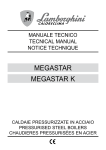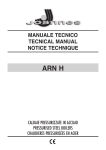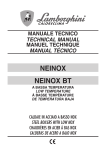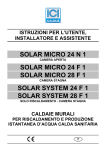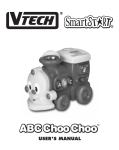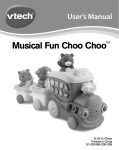Download ICI - Innovative Creations, Inc. AX User's Manual
Transcript
TECHNICAL MANUAL AX STEAM GENERATOR INDEX 1 TECHNICAL CHARACTERISTICS ........................................................................................................... 2 1.1 GENERAL............................................................................................................................................... 2 1.2 CHARACTERISTICS.............................................................................................................................. 2 1.3 TECHNICAL DATA................................................................................................................................. 3 2 ACCESSORIES ......................................................................................................................................... 4 2.1 PRESSURE ............................................................................................................................................ 4 2.1.1 Pressure gauge............................................................................................................................ 4 2.1.2 Operation pressure switch ........................................................................................................... 5 2.1.3 Safety pressure switch................................................................................................................. 5 2.1.4 Safety valves................................................................................................................................ 6 2.2 LEVEL..................................................................................................................................................... 6 2.2.1 Level indicator gauge................................................................................................................... 6 2.2.2 Automatic level regulator and water level limits........................................................................... 7 2.3 FEED WATER ........................................................................................................................................ 7 3 INSTALLATION ......................................................................................................................................... 8 3.1 SITING .................................................................................................................................................... 8 3.2 WATER CONNECTIONS ....................................................................................................................... 8 3.3 ELECTRIC CONNECTIONS .................................................................................................................. 9 3.4 SMOKESTACK ....................................................................................................................................... 9 3.5 BURNER................................................................................................................................................. 9 3.5.1 Boiler - Burner coupling ............................................................................................................... 9 4 BOILER OPERATION ............................................................................................................................. 10 4.1 FIRST START-UP ................................................................................................................................ 10 4.2 NORMAL OPERATION ........................................................................................................................ 10 5 MAINTENANCE ....................................................................................................................................... 11 5.1 ORDINARY ........................................................................................................................................... 11 5.2 PERIODIC............................................................................................................................................. 11 5.2.1 Periodic control (every 6 hours of use)...................................................................................... 11 5.3 SCHEDULED........................................................................................................................................ 13 5.4 ConservaTION DURING WHEN OUT OF SERVICE........................................................................... 13 5.4.1 Dry conservation ........................................................................................................................ 13 5.4.2 Wet conservation ....................................................................................................................... 13 6 WATER CHARACTERISTICS................................................................................................................. 14 6.1 FEEDWATER - LIMIT VALUES (entering the boiler) ........................................................................... 14 6.2 OPERATING WATER - LIMITING VALUES ........................................................................................ 14 6.3 FREQUENCY OF THE ANALYSES..................................................................................................... 14 7 TROUBLESHOOTING............................................................................................................................. 15 8 WATER LEVEL LIMITS........................................................................................................................... 16 8.1 GENERAL............................................................................................................................................. 16 8.2 TYPICAL APPLICATIONS.................................................................................................................... 17 8.3 ELECTRICAL CONNECTIONS............................................................................................................ 17 8.4 STEAM GENERATOR OPERATION ................................................................................................... 18 8.5 FIRST START-UP ................................................................................................................................ 18 8.6 MAINTENANCE.................................................................................................................................... 18 8.6.1 Ordinary ..................................................................................................................................... 18 8.6.2 Periodic control (every 6 hours of use)...................................................................................... 18 8.6.3 Extraordinary maintenance (water level limits substitution) ...................................................... 20 8.7 TROUBLESHOOTING.......................................................................................................................... 20 8.8 DATA LABEL ........................................................................................................................................ 21 1 TECHNICAL CHARACTERISTICS 1 1.1 TECHNICAL CHARACTERISTICS GENERAL The AX series steam boilers are type semi-fixed, horizontal smoke-tube type, complete with accessories. The boilers are suitable for operation with pressurised burners for gas, fuel oil or heavy oil. Safety, reliability, high efficiency and high quality saturated steam are the characteristics of our boilers. Please consult the instructions with attention. This high-pressure steam (12-15 kgf/cm2) generator uses a combustion chamber with flue gas inversion. For operation at up to 3000 kg/h of steam generated there is partial exoneration (in Italy) in the employment of specialist boiler operators. Local requirements as to personnel qualification MUST be taken into account for the country where the unit is installed. 1.2 CHARACTERISTICS • Working pressure switches for operation (controlling the 1st and 2nd burner flame). • Locking pressure switches (stops the burner on reaching the maximum steam pressure; the boiler is manually reset from the control panel). • Automatic level regulator (2 probes connected to an electronic conductivity relay maintain the water level between the set levels). • Water level limits (2 probes connected to two independent electronic conductivity relays stop the burner if the water level falls below the safe minimum; reset is manual on the control panel). 2 TECHNICAL CHARACTERISTICS 1.3 TECHNICAL DATA Fig. 1 LEGEND 1 Switchboard 2 Control pressure switches 3 Safety pressure switch 4 Pressure gauge st 5 1 safety level probe 6 Level control probes nd 7 2 safety level probe st 8 1 level gauge 9 Level gauge drain 10 Front plate Dimensions AX AX AX AX AX AX AX AX AX AX AX AX AX * 200 300 400 500 600 800 1000 1200 1500 1750 2000 2500 3000 Gasoil Heavy oil Total weight kg Electric supply Volt ~ Steam intake Feed Safety valves exhaust Boiler exhaust Safety valves fitting Lpg Steam capacity* kg/h N1 N2 N3 N4 N5 kcal/h 233 200.000 3,5 12 730 340 1500 3/N 400 50,0 IP55 4000 X X X X 349 300.000 3,5 12 940 510 1800 3/N 400 50,0 IP55 4000 X X X X 465 400.000 5,0 12 1090 680 2100 3/N 400 50,0 IP55 4000 X X X X 581 500.000 4,5 12 1380 850 2600 3/N 400 50,0 IP55 4000 X X X X 698 600.000 6,0 12 1585 1020 3000 3/N 400 50,0 IP55 4000 X X X X 930 800.000 5,5 12 2030 1360 3600 3/N 400 50,0 IP55 4000 X X X X 1163 1.000.000 7,0 12 2330 1700 4300 3/N 400 50,0 IP55 4000 X X X X 1395 1.200.000 8,0 12 2860 2040 4700 3/N 400 50,0 IP55 10000 X X X X 1744 1.500.000 6,5 12 3630 2560 6000 3/N 400 50,0 IP55 10000 X X X X 2035 1.750.000 7,5 12 4020 3000 6500 3/N 400 50,0 IP55 10000 X X X X 2326 2.000.000 8,0 12 4570 3410 7500 3/N 400 50,0 IP55 15000 X X X X 2907 2.500.000 9,0 12 6220 4270 10000 3/N 400 50,0 IP55 15000 X X X X 3488 3.000.000 9,5 12 6945 5100 11000 3/N 400 50,0 IP55 15000 X X X X H Total capacity l Rapid exhaust valve Exhaust valve Feed pumps kW Heat output Design Pressure bar 22 23 24 Nat. gas 200 300 400 500 600 800 2000 1200 1500 1750 2000 2500 3000 nd 2 level gauge Flame inspection hole Burner plate Steam take-off Non return valve Inspection door Safety valves Feed filter Back smokebox Smokestack connection Cleaning door Pressure losses flue gas side mbar Characteristics AX AX AX AX AX AX AX AX AX AX AX AX AX 11 12 13 14 15 16 17 18 19 20 21 Hz Insulation class IP Electric power W Frequency mm 1600 H1 mm 1240 H2 mm 575 H4 mm 1440 H6 mm 720 L2 L4 L P mm mm mm mm 1480 1080 1130 2060 P2 P6 Øb Øc mm mm mm mm 1508 280-330 180 250 1780 1400 640 1600 815 1640 1240 1290 2092 1511 310-360 225 250 32 1”1/4 1800 1400 640 1620 815 1640 1240 1290 2342 1761 310-360 225 250 40 1”1/4 1980 1560 700 1780 900 1800 1400 1450 2381 1760 350-400 280 300 40 2010 1560 700 1780 900 1800 1400 1450 2631 2010 350-400 280 300 2160 1710 735 1930 950 1950 1550 1600 2661 2220 1710 735 1940 950 2370 1850 2550 Fuel N4 DN/in 32 N5 DN/in 25 40 32 25 40 32 25 1”1/4 40 32 25 50 1”1/4 40 32 25 2010 370-420 280 350 50 1”1/4 40 32 25 1950 1550 1600 2961 2310 370-420 280 350 65 1”1/4 40 32 25 810 2080 1000 2100 1680 1730 3163 2512 370-420 320 400 65 1”1/4 40 32 25 1990 850 2240 1080 2260 1840 1890 3413 2710 420-470 360 450 80 1”1/4 40 32 25 2550 1990 850 2240 1080 2260 1840 1890 3713 3010 420-470 360 450 80 1”1/4 50 32 32 2710 2150 880 2390 1240 2450 1950 2000 3785 3013 480-530 360 500 80 1”1/4 50 32 32 2900 2300 950 2550 1240 2600 2100 2150 4283 3504 480-530 400 550 100 40 50 40 32 3000 2400 970 2615 1300 2700 2200 2250 4626 3754 480-530 400 600 100 40 65 40 40 80°C feeding water 3 N1 N2 N3 DN/in DN/in DN/in 32 1”1/4 40 ACCESSORIES 2 ACCESSORIES AX steam boilers are fitted with a series of accessories that can be subdivided as follows: • Safety accessories (safety valves, water level limits, safety pressure switches). • Observation accessories (level gauge, pressure gauge, flame inspection). • Control accessories (level ad pressure switches). • Feed water accessories (centrifugal pump, injector or alternating steam pump). • Manual operation accessories (stop valves, purge valve). In the following description the accessories are subdivided as to the physical parameter they control (pressure and level). 2.1 PRESSURE 2.1.1 Pressure gauge (Fig. 2) The pressure gauge is Bourdon type consisting of a flat elliptical section metal tube, bent to an arc. One end of the tube is open and communicates with the boiler where the pressure is to be measured; the other end, closed and free to move is connected by a lever system to a toothed arc and to the gauge indicator hand. The gauge shows in red the design pressure. The gauge is carried on a three-way valve to allow the following operations: • Communication between boiler and gauge (normal operation position). • Communication between gauge and the atmosphere (position necessary to purge the siphon). • Communication between the boiler, the gauge and a test gauge (position necessary to verify the gauge). Fig. 2 4 ACCESSORIES 2.1.2 Operation pressure switch Device that controls the boiler pressure and holds the pressure between the set maximum and minimum values. Instructions for adjustment. The electric switch has three screws (2-1-3 from right to left). On reaching the set pressure, the contact 2-1 switches to 2-3. Adjustment of the pressure switch (Fig. 3): a) Turn the knob (1) until the scale indicator (2) reaches the pressure at which the burner shall restart. b) Remove the cover of the pressure switch and position the drum (3) at the value selected for the pressure differential (stopping the burner) as to the diagram Fig. 4. Example: * Type of pressure switch: RT 5 * Scale indicator 9 bar * Drum indicator: 4 corresponding to 2,1 bar * Burner start: 9 bar * Burner stop: 11,1 bar Fig. 3 Fig. 4 2.1.3 Safety pressure switch This switch is set at a higher pressure than the maximum of the control pressure switch, but always lower than the opening pressure of the safety valves. The safety pressure switch acts in the case of a fault to the control pressure switch and stops the burner permanently. Restarting the burner can only occur after the steam pressure has fallen and after a manual reset on the switchboard. This pressure switch is adjusted in a similar manner to that of the control pressure switch, with the only precaution that the drum indicator is set to 1 so that the differential is effectively nil. 5 ACCESSORIES 2.1.4 Safety valves These valves have the function of discharging steam when the maximum design pressure of the boiler is reached. The valves used on boilers can be of the type Lever and weight (Fig. 5) or Spring (Fig. 6). The boiler operator must pay much attention to the safety valves and carry out careful and diligent maintenance. The safety valve is the most important and sensitive accessory on the boiler and represents the best guarantee that the internal pressure of the boiler does not exceed the design pressure. As during normal operation of a boiler, the safety valve never acts, it is good practice to check that the valve is free, i.e. that the valve plug is not stuck to the seat, by acting on the side lever (spring valves) or on the horizontal lever carrying the weight (lever and weight valves) until the valve starts to discharge steam. WARNING On first start-up, you must verify that safety valve Fig. 5 adjustment is made to the boiler design pressure. Generally the spring safety valve is supplied already adjusted, while the lever and weight type must be adjusted by moving the weight along the lever until the opening pressure value corresponds to the boiler design pressure. The safety valve installed on steam boilers must have the discharge piped to outside the boiler room. Particular care must be taken in designing the discharge line; we show some here. • The discharge line should e of diameter at least equal to that of the discharge flange on the safety valve. • Only wide radius curves must be used in the discharge line. • The entire discharge line must be built to avoid the formation of condensation locks. There must be therefore adequate slopes to ensure complete drainage. Particular care must be taken if the valve seat and plug are to be ground; if this operation becomes necessary due to leaks, use abrasives based on silicon carbide or oil based carborundum. Carry out the first grinding operation using fine grain abrasive, finishing with a very fine grain abrasive. 2.2 LEVEL Fig. 6 2.2.1 Level indicator gauge The level indicator consists of a pair of valves connected to a sight glass box containing a prismatic glass. This device is connected to the boiler both above and below the normal water level, while the lower part is fitted with a purge valve so that any sludge can be removed, to keep the glass clean. Using these valves, the efficiency of the level control system can be verified periodically by carrying out the following operations: • Open for a few seconds and then close the purge valve. If the water disappears from the sight glass and then appears again with ample level oscillation, then it can be considered that the level operates correctly. If on the other hand the water returns slowly or stops at a level differing form the preceding level, then on of the communications may be obstructed. To make sure which of the two is obstructed, and to attempt a purge, close the steam valve leaving the water valve open, then open the purge valve. This valve must release water taking with it any sludge formed in the pipes. Then close the water valve and open the steam valve: steam should be released from the purge valve. Closing the purge valve and leaving the two water and steam valves open, the water should return to the initial level. If this does not occur, the communication pipes between the level and the boiler must be cleaned. 6 ACCESSORIES 2.2.2 Automatic level regulator and water level limits (Fig. 7) The physical principle employed to detect and control the water level is based on the electrical conductivity of the water. The control device consists of a part sited in the control panel (electronic relays) and of probes of differing lengths immersed in the boiler shell. Operation of the system provides for: • Automatic pump start and stop: Two probes inserted in the boiler, of which the longer starts, and the shorter stops the pump, connected to a single control relay in the control panel. • Burner stop at low water level: two probes of the same length, inserted in the boiler and connected to two distinct control relays in the control panel, stop the burner permanently if the water level drops below the admissible level. Boiler probes: 6 7 8 9 Pump stop Pump start 1st safety burner stop and alarm on. 2nd safety burner stop and alarm on. N.B.: we suggest that as well as the acoustic alarm in the boiler room, a further acoustic alarm be provided in an area where personnel is normally present. Fig. 7 2.3 FEED WATER An electric centrifugal pump supplies the water. The inlet side of the pump must never be under suction pressure, but always under positive pressure due to the difference in height between the pump itself and the feed water tank. While a pump can operate under suction head from a cold water tank (up to 5-6 m), if the water is hot the pump cannot operate and indeed needs the water to be delivered under a certain pressure. The height of the feed water tank varies with the temperature, as shown in the following table: Feed water temperature (Celsius) 60 70 80 90 Positive water head (metres) 1 2 3 4,5 WARNING • Avoid the use of feed water at temperatures lower than 60 Celsius, being rich in Oxygen and therefore such as to cause corrosion. • To avoid pump cavitation problems, the feed water temperature should not be higher than 90 Celsius. 7 INSTALLATION 3 3.1 INSTALLATION SITING Our steam boilers are supplied as units and do not need any foundation work. A flat even floor only is needed, that can be raised by 5-10 cm. 3.2 WATER CONNECTIONS The steam boilers once positioned are connected to the system as follows (Fig. 9): Water From the condensate collection tank (10) (if existing; otherwise from the treated water tank) to the suction side of the feed water pump (9). Steam From the main steam take-off valve (3) to the user services (distributor or others), from the safety valve outlets (6) to outside the boiler room in a safe position. Drains From the level indicator drains (16), the boiler drain (17) to the drainage network. Fuel Connection to the burner foreseen for fuel oil or natural gas. Fig. 9 – System diagram 10. 11. 12. 13. 14. 15. 16. 17. 18. 19. LEGEND 1. Boiler 2. Smokestack 3. Steam take-off 4. Burner 5. Pressure switches 6. Safety valves 7. Condensate return 8. Electric pump supply 9. Feed water pumps 8 Condensate collection tank Water level Water treatment Water supply Breather Condensate tank drain Level indicator drain Boiler drain Safety valve drain Example of user service INSTALLATION 3.3 ELECTRIC CONNECTIONS The boilers are provided with a switchboard (protection level IP 55) completely assembled to the various boiler accessories. Before connecting the switchboard, make sure that the electric system has been correctly installed, checking in particular the efficiency of the earthing system. Wiring diagram Refer to the diagram supplied with the specific switchboard. 3.4 SMOKESTACK The connection from the boiler to the base of the smokestack must slope upwards in the direction of the gas flow, with a slope that should be at least 10%. The path should be as short and as possible and the bends and connections designed as to the rules used in the design of air ducts. For lengths of up to 2 metres, the same diameter as the boiler flue gas outlet can be used (see the technical specification table). For more tortuous paths, the diameter must be suitable increased. The smokestack must in any case be dimensioned as to applicable regulations. It is advisable to pay great attention to the inside diameter, insulation, gas tightness, ease of cleaning and to the fitting required for taking flue gas samples for combustion analysis. 3.5 BURNER To better answer to steam demand, it is advisable to install a two-stage burner or a modulating burner; this avoids large pressure variations consequent on sudden stream demands. Further, and above all with natural gas, every burner start-up is preceded by a long period of preventilation of the combustion chamber, with consequent loss of heat to the smokestack. 3.5.1 Boiler - Burner coupling Verify that the spaces between the burner sleeve and the boiler door are suitable filled with flame-resistant ceramic insulation (Fig. 10). P6 Fig. 10 Øb KEY: 1. Burner 2. Manhole 3. Thermoinsulating material 4. Flange 1 3 4 2 All details on the draught tube lenght (P6), the diameter of the burner hole (Øb) and the pressurization are included in the par. Technical Specifications. 9 BOILER OPERATION 4 4.1 BOILER OPERATION FIRST START-UP WARNING: Before start up insert all the turbolators into the smoke tubes ensuring that there is a space of at least 100 mm at the front after they have been pushed fully inside. • Verify that all fittings are tight. • Verify that the feed water pipes are clean, carrying out a series of washing operations with drainage to waste before final boiler filling. • Close the drain valves, the steam take-off valve and the level drains. • Open the level control valves and the feed water valve (upstream of the feed water pump). • Check that the upper man-way is correctly closed. • Start the boiler as follows: 1) Switch on the control panel by turning the main switch. 2) Check that the drive shaft of the feed water pump is free to turn. By starting the pump manually for an instant, check that the shaft turns in the correct direction. 3) Set the pump switch to AUT and verify that burner cannot start before the attainment of the minimum level; 4) Check that the pump stops when the maximum level is reached by observing the level indicators and checking the positions of the indicator valves. 5) Press and keep pressed the safety water level reset button for at least 10 seconds, the conductivity relay being of the delayed type. 6) Open the boiler drain and check on the level indicator at what level the pump-start probe acts. 7) Set the pump switch to “0” leaving the drain open and check the actuation level of the safety probes with respect to the minimum level reference plate. 8) Close the drain and set the pump switch to AUT 9) Switch on the burner and bring the boiler up to pressure adjusting the operation pressure. WARNING: On boilers with a man-way, during the first start-up it is important to tighten progressively the nuts on the man-way cover as the pressure increase. Otherwise a hazardous situation is created due to steam leaks that quickly deteriorate the gasket creating a dangerous situation for the boiler room personnel. 4.2 NORMAL OPERATION With cold start-ups, verify that: • • • • The boiler is full of water to the minimum level; The increase of the water volume due to heating does not raise the water level too far: if necessary drain the boiler at regular intervals to bring the visible level back to the centre of the water level sight glasses; On reaching the set pressure, the steam take-off valve can be opened very gradually in order to heat the steam delivery lines eliminating any condensate that may be present in the pipework; The man-way gasket does not leak. 10 MAINTENANCE 5 5.1 • • • • • • • • 5.2 MAINTENANCE ORDINARY Periodically purge the level gauges, probe holder if fitted and the boiler, to avoid the accumulation of sludge; Check the efficiency of the control and regulation instruments, examining carefully the electrical parts (connections included) and the mechanical parts (pressure switches); it is advisable to replace every year the ceramic probe-holders; Carry out burner maintenance (as to the specific instructions); Check the tightness of flange bolts and the state of the gaskets; Check the conditions of the boiler door internal covering; Clean the flue-gas tube bundle and the turbolators; Carry out correct maintenance to the pump (bearings, mechanical seal), Check for wear to the discharge valves; these tend to wear more quickly, due to the abrasive effect of the sludge during blow-down. PERIODIC 5.2.1 Periodic control (every 6 hours of use) From time to time (every 6 hours of use) the thermal plant must be inspected by qualified personnel to check the efficiency of all safety accessories: • Safety pressure switch • Water level limits The system can be reset if no anomalies have been encountered: power off the panel for approx. 20 seconds, power on the main switch and press the reset buttons. For further details follow the flow chart below: 11 MAINTENANCE 12 MAINTENANCE 5.3 SCHEDULED All boilers must be periodically stopped for careful inspection and maintenance: the time interval between stops is established by experience, by the operating conditions, by the quality of the feed water and by the type of fuel used. Before entering the boiler shell for inspection or for cleaning, check carefully that there is no possibility of entry of water or steam via the pipework to which the boiler is connected. Every valve must be locked and if necessary isolated by removing a piece of pipework or by inserting a blind flange. The parts under pressure must be carefully examined internally to identify any encrustation, corrosion and other potential sources of danger linked to the feed water. All deposits must be removed mechanically or chemically and the effective thickness of the structures must be verified using suitable instruments to determine that they are equal to or greater than the design values. All pustules or other types of corrosion must be scraped and cleaned with a steel wire brush to white metal. Leaks between fire tubes and tube plates must be carefully examined: any welding must be done in all cases observing legal obligations, without forgetting that a steam boiler is a pressure vessel with danger of explosion and subject to control by competent authorities. During inspection also verify all the accessories, with priority to safety valves, level probes and pressure switches. 5.4 CONSERVATION DURING WHEN OUT OF SERVICE Often during periods of disuse the worst cases of corrosion appear. The operations to be carried out to guarantee correct conservation of the boiler depend essentially on the duration of the stop. The boiler can be subjected to dry conservation if the period of disuse is long, or to a wet conservation for short stops or if the boiler has a back-up function and must be ready to come on-line in a short time. In both cases, the necessary operations tend to eliminate the causes of possible corrosion. 5.4.1 Dry conservation The boiler must be drained and dried carefully, then placing in the boiler shell a hygroscopic substance (for example lime or silica gel etc) 5.4.2 Wet conservation The boiler must be filled completely, given that corrosion is a phenomenon that appears due to the simultaneous presence of water and Oxygen. Therefore all traces of Oxygen must be removed from the water, also avoiding the successive infiltration of air. There are substances that absorb Oxygen, such as hydrazine and Sodium Sulphite, but after their use the water alkalinity must be checked. 13 WATER CHARACTERISTICS 6 WATER CHARACTERISTICS For steam generators with heating surface over 15 sqm, there are some regulations that require limit values for water characteristics. These values are listed in the tables below. However, limits should be adopted for all generators as stated by qualified companies that recommend the type of treatment to be carried out basing on careful analysis of the available water. Many faults and sometimes serious accidents are caused by the use of water with non-conforming features. 6.1 FEEDWATER - LIMIT VALUES (entering the boiler) Tab.1 Characteristics pH Total hardness Oxygen (1) Free Carbon Dioxide (1) Iron Copper Oily substances Aspect Unit of measurement mg/l CaCo3 mg/l O2 mg/I CO2 mg/l Fe mg/l Cu mg/I Pressure ≤ 15 bar Pressure ≤ 25 bar 7 $ 9,5 7 $ 9,5 10 5 0,1 0,05 0,2 0.2 0,1 0,1 0,1 0.1 1 1 Clear, limpid, no persistent foam. (1) These values are valid to have a thermo degassing device. Without degassing device, the temperature of the tank water must be increased to at least 80 Celsius (see chapter 2.3. - Feeding) to reduce the content of dissolved gasses (O2 and CO2). Chemical deoxygenators must be used to remove completely the oxygen from the feed water and reduce as much as possible CO2 corrosive effects. 6.2 OPERATING WATER - LIMITING VALUES Tab.2 Characteristics pH Total alkalinity Total hardness Maximum conductivity (4) Silica STD (4) Conditioner (2) Aspect Unit of measurement Pressure ≤ 15 bar 9 $ 11 1000 10 8000 150 3500 mg/l CaCo3 mg/l CaCo3 µS/cm mg/l SiO2 mg/l Pressure ≤ 25 bar 9 $ 11 750 5 7000 100 3000 Clear, limpid, no persistent foam (1) To maintain in the boiler the parameters of alkalinity and silica within the prescribed or recommended limits, the boiler must be purged, if possible continuously. The values of the concentrations in the feedwater and in the boiler water are linked to the continuous purge by the following relationship: S % = 100 Ca Cc Where S% Ca Cc = Percentage of purge with respect to the feed water supplied to the boiler; = Real concentration of a certain salt or ion in the feed water = Maximum allowed concentration in the boiler for the same salt. (2) Correct management presupposes normally the use of conditioners, whose dosages and limits are in relation to the nature and characteristics of the additives themselves. (3) Determined on a filtered sample (4) The two parameters have the same physical meaning but the values can be correlated only if the chemical composition of the water is known. 6.3 FREQUENCY OF THE ANALYSES The frequency of analysis is determined evidently as a function of the use of the boiler and of the quality of the water used; it is advisable in any case to check the pH, the total hardness and the alkalinity of the feed and boiler waters at least every two days. Once a month, especially under conditions of variable operation, it is advisable to subject meaningful samples of the boiler and feed waters to complete analysis. It is also advisable to inspect the return condensate for traces of any highly contaminating oily substances (reduction of evaporation from the water surface in the boiler caused by a layer of oil). 14 TROUBLESHOOTING 7 TROUBLESHOOTING FAULT Safety valve/s opening PROBABLE CAUSE Maximum pressure exceeded, as set on the valve. Must be equal to the boiler design pressure. Loss of the adjustment of the safety valve SUGGESTED REMEDY Adjust the safety pressure switches and / or limit switches. Check and then adjust the valve using a reference gauge Clean the seat by opening the valve Small leaks from the safety Dirt on the valve seat manually a few times valve/s Marks on the valve seat Dismantle the valve and regrind the valve seat with very fine abrasive. Pump overload relay has acted Check the motor current Pump stopped Check the relay setting Pump shaft seized Maintenance to the pump Pressure limit switch set too high Adjust the pressure limit switch Pressure safety switch operates Pressure limit switch faulty Replace the pressure limit switch Pressure switch pipe coil blocked Clean or replace the pipe coil Water level detection interrupted Steel probe encrusted Safety level 1 or 2 operates Connection cable interrupted Safety level relay faulty Temporary replacement of the safety electronic relay with one of the two relays in the panel. If the problem disappears, replace the faulty relay. No water feed See faults "feed water" Pump seized See faults "Pump stopped" Feed water insufficient Pump suction filter blocked Clean the filter Level control faulty Temporary replacement of the electronic control relay with one of those present in the panel. If the problem disappears, replace the faulty relay. Level probes short circuited Dismantle the control probes for inspection of the ceramic insulation Pump cavitation Suction head (difference in height between supply tank and pump) insufficient in relation to the water temperature Clean the pump suction filter Reduce the head loss in the pipe between collector tank and the pump by increasing the pipe section Pump rotation direction Invert two phases (three-phase pump) Erroneous electrical connection to the Consult the wiring diagram Burner always ON panel Safety level relays faulty See “Intervention safety level 1 or 2” Control and/or safety pressure switches Check the adjustment of the pressure switches inactive Check the pressure switch connections to the control panel Problems with the burner See the specific burner Manual Burner always OFF Burner fuses interrupted Replace the fuses No consent to the burner from the control Replace the control pressure switch pressure switch No consent to the burner from the safety See “Intervention safety level 1 or 2” level relay Erroneous connection to the control panel Consult the wiring diagram 15 WATER LEVEL LIMITS 8 8.1 WATER LEVEL LIMITS GENERAL The water level limits consists in: n. 2 level rods, n. 2 probes, electrical cables, n. 2 electronic relays. The device prevents the lowering of the level of water in the steam generators and the consequent overheating of the membrature. The principle of survey and control of the level is based on water conductivity. In order to guarantee the correct operation of the device, following conditions must be fulfilled: • • • Water conductivity > Water temperature < Pressure < 250 µS/cm 210°C 20 bar (See. " Operating water " - Tab. 2 ). EXAMPLE: PROBES TANK FOR SAFETY AND REGULATION 16 WATER LEVEL LIMITS 8.2 TYPICAL APPLICATIONS Boiler probes: 6 Pump stop 7 Pump starting 8 1st burner cut-out safety device and alarm ON. 9 2nd burner cut-out safety device and alarm ON NOTE: it is recommended that an alarm bell is installed in the boiler room as well as a sound or visual alarm in highly visited rooms. 8.3 ELECTRICAL CONNECTIONS Refer to the diagram supplied with the specific switchboard. 17 WATER LEVEL LIMITS 8.4 STEAM GENERATOR OPERATION (Water level limits) 8.5 • FIRST START-UP Start the boiler, as follows: 1 Power up the boiler control panel 2 Make sure that the motor-driven pump drive shaft is free to rotate and that rotation direction is correct. 3 Set the pump selector switch on AUT and verify that burner cannot start before the attainment of the minimum level; 4 Make sure that the pump stops when the maximum level is reached, observing level indicators and checking the position of their cocks; 5 Maintain safety level reset pressed for 10 sec because it is employed an electronic delayed relay 6 Open the boiler discharge and check on the level indicator the intervention point of probe pump start 7 Set the pump selector switch on "0", leaving the discharge open, and check the intervention level of safety probes, referring to the minimum level information plate; 8 Close the discharge, place pump selector switch to AUT; 8.6 MAINTENANCE 8.6.1 Ordinary • Bleed periodically (level indicators, probe-holder barrel if any, boiler) to avoid mud deposits. • Check the efficiency of the regulation and control instruments by inspecting carefully the electrical (also connections); it is also recommended that the probe-holder ceramic plugs are replaced every year 8.6.2 Periodic control (every 6 hours of use) From time to time (every 6 hours of use) the thermal plant must be inspected by qualified personnel to check the efficiency of all safety accessories: • Water level limits • Safety valve The system can be reset if no anomalies have been encountered: power off the panel for approx. 20 seconds, power on the main switch and press the reset buttons. For further details follow the flow chart below: 18 WATER LEVEL LIMITS 19 WATER LEVEL LIMITS 8.6.3 Extraordinary maintenance (water level limits substitution) To replace the water level limits or parts of it, follow strictly the instructions below: 1. Ensure that the new ceramic plug is intact 2. Check the length of the rod 3. Ensure that the rod is coaxial to the plug axis 4. Inspect the electrical system and, in particular, ensure that the resistance of the electric circuit linking the ceramic plug to the electrical panel is intact (resistance must be over 10 MOhm) 5. Ensure that the automatic level control consisting of the two ceramic plugs and their conductivity-relays, work well 8.7 TROUBLESHOOTING FAULT Safety intervention level 1 or 2 Insufficient water load Burner always on Burner always off POSSIBLE CAUSE Interrupted water level monitoring RECOMMENDED REMEDY Scaled stainless steel bar Broken connection cable Faulty safety level relay Temporary replace the safety electronic relay with one of the two relays in the panel. If this is the problem, replace definitively the faulty relay. Water does not load See “Loading” inconv. Blocked pump See. “Blocked pump” inconv. Dirty pump sucking filter Clean the filter Level regulation anomaly Temporary replace the safety electronic relay with one of the two relays in the panel. If this is the problem, replace definitively the faulty relay. Level regulation probes short circuit Dismantle the adjustment probes to inspect visually the ceramic insulation Pump cavitatation Insufficient head (=different height between the collecting vessel and the pump levels) in comparison with water temperature Clean the pump sucking filter Decrease the pipe resistance between the collecting vessel and the pump by increasing the passage section Pump sense of rotation Invert one of the two phases (three-phase pump) Incorrect electrical panel connection Consult the electric diagram Faulty level safety relays See “Safety intervention level 1 or 2” Regulation pressure and/or safety switches Check the pressure switches regulation OFF Check the pressure switches connection to the electrical panel Burner problems See burner manual Interrupted burner fuses Replace fuses Lack of burner consent from the regulation Replace regulation pressure switch pressure switch Lack of burner consent from the level safety See “Safety intervention level 1 or 2” relays Incorrect electrical panel connection Consult the electric diagram 20 WATER LEVEL LIMITS 8.8 DATA LABEL ICI CALDAIE S.p.A. Via G. Pascoli, 38 - S.S. 434 km 9 37059 ZEVIO/Fraz. Campagnola VERONA - ITALIA Tel. 045/8738511 -fax 045/8731148 LIVELLOSTATO DI SICUREZZA WATER LEVEL LIMITS Modello / Model GP1 Boiler serial number N.fabb. / Serial number Conducibilità dell’acqua Water conductivity > 250 µS/cm PS max TS max Fluido / Fluid Data/Date Volt / Freq. / Pot. - Power 20 bar 210°C Acqua / Water 24 VAC / 50-60 Hz / 3 VA Omologazione/Approval 1370 IL LIVELLOSTATO DI SICUREZZA DEVE ESSERE VERIFICATO OGNI 6 ORE DI FUNZIONAMENTO WATER LEVEL LIMIT SHALL BE TESTED PERIODICALLY FOR A MAX OF 6 HOURS (ved. MANUALE TECNICO/see TECHNICAL MANUAL) 21 Boiler final test date Appartenente al Gruppo Finluc, iscritto R.I. VR n. 02245640236 Via G. Pascoli, 38 - 37059 Zevio - fraz. Campagnola - VERONA - ITALIA Tel. 045/8738511 - Fax 045/8731148 [email protected] - www.icicaldaie.com The data reported are indicative only and are not binding. Our company reserves the right to introduce alterations at any time, as it deems fit and proper for the development of the product. 96020005 Ed. 13-05/09 13 - St. 10 – 05/09

























